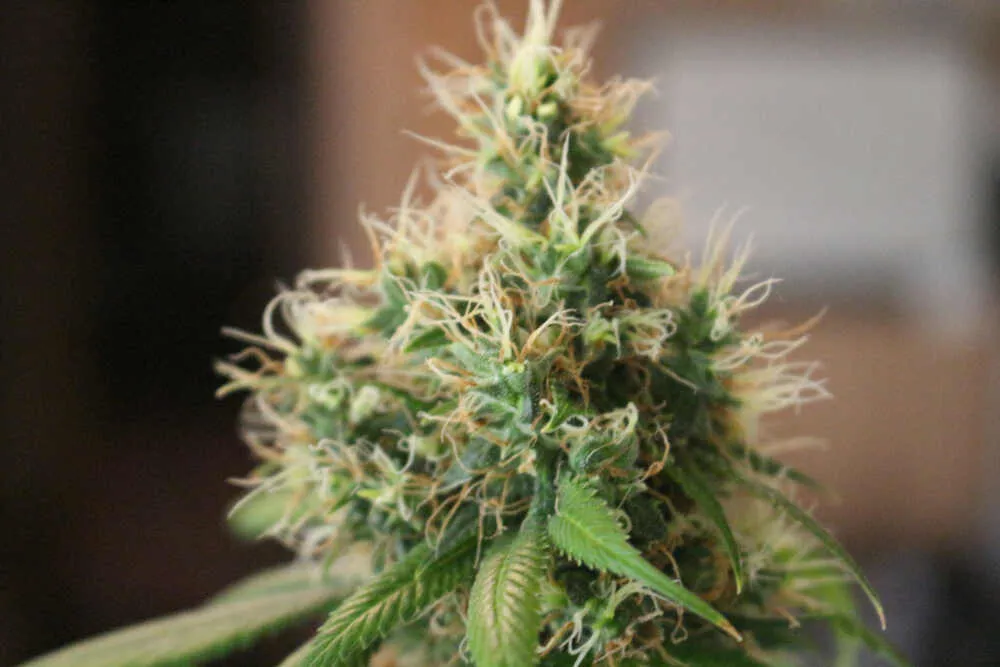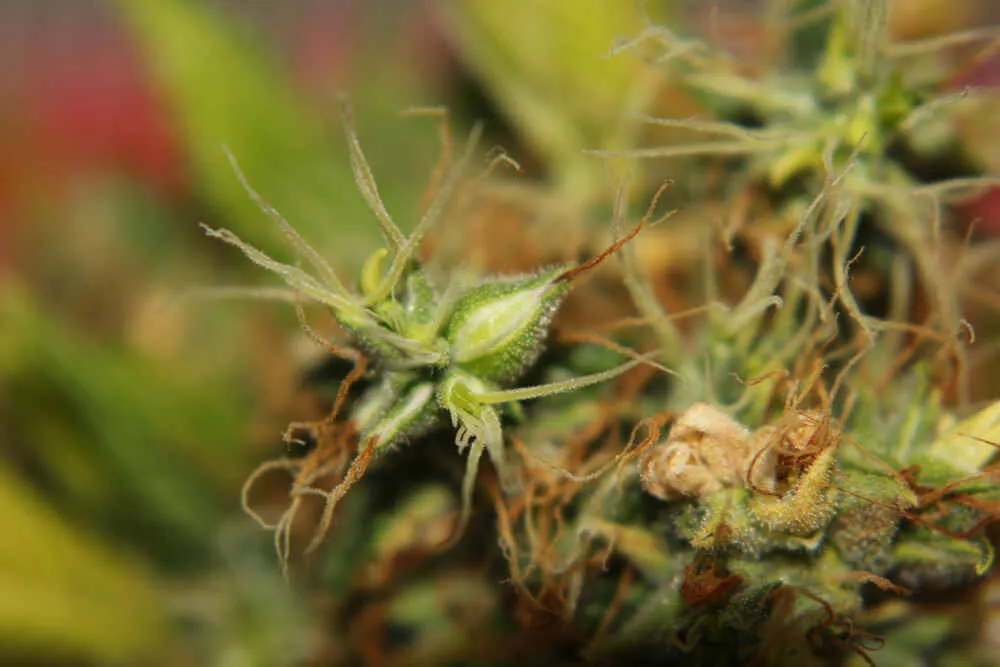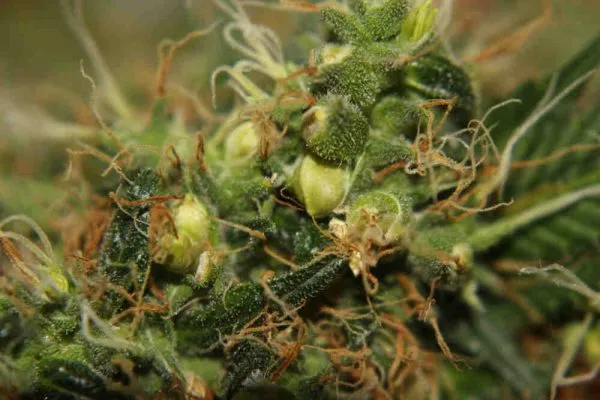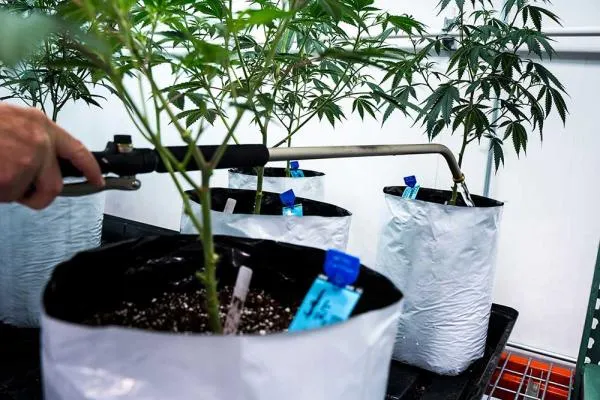Cannabis plants come in all shapes and sizes. Tall, lanky, euphoria inducing Sativas. Shorter, bushier, stress-relieving Indicas. Rare, exotic, hard-to-find landraces. And then there is the unbelievably massive range of hybrids available in this brave new world of cannabis legality, offering pretty much every type of cerebral and body-buzzing effect imaginable.
And while the veritable smorgasbord of strains available to the wider cultivation community is expanding almost daily, with the genetics reaching previously unimaginable peaks in terms of cannabinoid and terpene potency, there are a few issues that will just never be entirely bred out of the picture. One of them is hermaphroditism, which can quickly and easily ruin a whole crop - and lead to months of work down the drain.
- What is a hermaphrodite plant?
- What causes a plant to turn into a hermaphrodite?
- How do I know if my plant is a hermaphrodite?
- What to do if you have a hermie plant?
- Can A Hermie Plant Pollinate Itself?
- How Do You Force A Plant To Turn Hermie, And Why Would Growers Want To?
- Do Hermie Plants Still Produce Buds?
- The Wrap Up
What is a hermaphrodite plant?
Ok, before we get into the weeds, let's start at the very beginning.
In the most straightforward of terms, hermaphroditism in marijuana plants is defined as the presence of both male and female reproductive organs on the same plant.
Female plants usually start their flowering cycle with a few wispy white pistils (that's those little pale hair-like growths that signal the beginning of the flowering growth stage) emerging from the internodes. As time passes and light cycles shorten, those same pistils become thicker and longer, eventually turning into the buds that we all know and love.
Male plants, however, will usually be seen to be sprouting small, spherical-shaped pods once they reach the flowering stage. These are known as sacs and contain thousands of pollen grains. A single male plant produces enough pollen to inseminate a whole crop and can spread its seed as far as 3 miles away, wind and weather dependent.
So, hermie ganga plants produce both buds and pollen sacs - simple. Or is it?
Not really...
What causes a plant to turn into a hermaphrodite?
There is a range of factors that can contribute to the emergence of hermaphroditic plants. The most common culprits include:
- Stress - Plant stress comes in a variety of forms, including heat and light stress, nutrient deficiencies or toxicity, root shock, over/under watering, and environmental disturbances.
- Indoor-grown plants are more susceptible to certain forms of stress, with light leaks (where the crop is exposed to light outside of the predetermined lighting schedule) being a common cause.
- Genetics - Certain strains of cannabis are more predisposed to hermaphroditism than others, with pure Sativas and certain Skunk or Haze-based hybrids being particularly susceptible.
- Environmental Factors - Changes in day length, temperature/humidity fluctuations, and light intensity can lead to hermaphrodite tendencies.
- Poor Quality Soil - If you're using poor-quality soil, it could be lacking in essential minerals and nutrients that your plants need to stay healthy.
- Low-Grade Nutrients - Hydroponic plants need access to a range of high-quality nutrients and supplements, made specifically for cannabis cultivation. Low-grade or inferior products may contain heavy metals or other contaminants, or may just be balanced incorrectly which can lead to plants turning hermie.
- The Wrong pH At The Root Zone - A pH range that is too high or low can have a dramatic effect on your crop and make them more likely to display hermaphroditic tendencies.
- Low-Quality Seeds - Not all seeds are created equally, and not all seed banks produce the highest quality genetics. Poorly kept or mishandled seeds may harbor genetic defects that can lead to hermaphroditism.
You (the cultivator) should be checking your plants, and the environmental conditions in the grow area daily. Doing so will lower any chances of the causes of hermaphroditism mentioned above, and increase the chances of a successful harvest.
How do I know if my plant is a hermaphrodite?
That really depends on how far along your plant is. Let's take a step back, and check out the early signs that you need to be on the lookout for…
What are the first signs of a hermie?

There is one main sign to look out for when it comes to hermaphroditism in cannabis plants, and that is the development of male sex organs within the buds themselves. It is almost impossible to know whether a plant may turn hermie during the vegetative period as there won't be any evidence of hermaphroditic tendencies at that stage. It is only once the flowering growth period begins and the plants show their sex that we can start to keep an eye out for hermies. To be able to spot the early signs of a hermie, its important that you first understand how to sex your cannabis plants and what the difference between a male and female plant is.
So, we should be on the lookout for those spherically shaped pollen sacs?
Yes, and no…
You see there are actually two forms of hermaphroditism that can affect cannabis plants, with the two forms showing slightly different types of pollen sacs.
First up we have 'true' hermies. This is where genetics is the issue (for the vast majority of true hermies, anyway - stress can be a factor also, but less so than genetics), with the plant forming both female flowers and the sphere-shaped male pollen sacs - usually just below the buds. This is considered a naturally occurring trait of the particular plant or strain, and any cuttings taken from the plant will also result in hermaphroditic plants.
While non-true hermie weed plants (also referred to as bisexual, intersex, or mixed-sex plants) do produce male reproductive parts, they differ from true pollen sacs in one very particular way. Intersex Hermies grow what is commonly referred to as 'nanners'. This is due to the fact that the pollen sacs on these plants aren't shaped like tiny little footballs, but more closely resemble miniature green bananas. They usually form in small bunches, and start out green while slowly changing into a more pale yellow hue as they develop. They grow directly out of the buds themselves, and it is these particular traits that make them so distinctive.
'True' hermies will usually start developing both male and female sex organs at the same time, right when the growth stage switches from vegetative growth to flower production - Intersex plants, on the other hand, can develop 'nanners' at any time during the flowering period, and are more commonly seen once the flowers have started to fully develop.
The presence of either true pollen sacs or nanners on your plants is a sure fire sign that they are suffering from one of the two forms of hermaphroditism. If you stumble across any male organs at all, then it's time to take action….
What to do if you have a hermie plant?
A heavily debated topic to be sure, but in our opinion (and many other growers) the best option is to immediately remove the plant from the growing area and discard it. A single hermie plant can pollinate an entire crop, so it's best to get rid of it as soon as possible.
This is especially true for true hermies, as they will start to develop pollen sacs right at the beginning of flower growth. These pollen sacs only take around 3 to 4 weeks to ripen, at which point they will release the pollen grains - all of which have the potential to pollinate nearby plants.
For intersex hermie plants (the ones with the small bunches of nanners), it really depends on when the male organs appear. If this happens near the start of the flowering growth stage, then you will want to remove the plant as soon as possible. But, if they start to appear much later in the flowering period (say 4 weeks or so before harvest) then it is possible that you can wait until the nanners are close to ripening and then just harvest the buds a little earlier than you may have had the plant not turned hermie. Cannabis seeds take around 15 days from pollination to grow, so as long as you cut the plant down just before the nanners burst (or just after), then the buds should be fine, albeit a little smaller and lower in potency. Better than nothing, yeah?
Yes, but if you do wait until the nanners burst, the other female plants in the grow room or area may be pollinated, so it can be a pretty big gamble depending on your particular setup.
Can You A Reverse A Plant That Has Hermied?
No, not safely anyway.
If you asked this question just a few short years back, the answer would have been a resounding yes. There was an almost miracle cure available for almost a decade from the Dutch Master brand called "Dutch Master Reverse", but it has been pulled from shelves, and for good reason.
The product contained a type of chemical known as PGRs or Plant Growth Regulators. You can still find the stuff online, and even in some less-than-reputable hydroponic supply stores, but we cannot stress heavily enough that you just should not use it. PRGs have been proven to be highly carcinogenic for humans and can have some other nasty long-term side effects. It's best to just avoid that stuff completely.
If you are dealing with a true hermie with just a few pollen sacs then you can carefully remove them by using the pinch-and-pull method. But if the sacs have developed close to the point of pollen release, it's best to just remove the plant and discard it.
The best way to prevent your plants from turning hermie is to ensure that you are providing them with the right environment, top quality nutrition, and avoid causing high levels of stress to the plants. Even commonly used, accepted forms of high-stress training (HST) can result in hermaphroditism in plants, so it's best to really know a strain inside and out before you start combining HST techniques.
Can A Hermie Plant Pollinate Itself?
Yes, hermies can pollinate themselves, and will do if left to their own devices. This is why it is so important to remove a hermie plant from the growing area as soon as you spot any male organs. It's also possible for the pollen from a hermie plant to pollinate other, nearby female plants, so it's important to keep a close eye on your garden, and to take prompt action if you ever spot a hermie.
Hold up though, there is one specific situation where cultivators may want to allow a hermie to pollinate itself, and may even force a plant to turn hermie…
How Do You Force A Plant To Turn Hermie, And Why Would Growers Want To?
We have all heard of feminized seeds, right?
One of the huge advancements in cannabis in the last 50 years, feminized seeds take a bunch of the guesswork out of growing. With feminized genetics, you don't have to worry about male plants popping up and ruining a crop, creating a lot of extra work for growers. Feminized seeds are created through a process known as rodelization, and it involves deliberately stressing out a female plant to the point of inducing her to turn hermie.
There are a few ways that growers go about this, the most common being through the use of colloidal silver. Colloidal silver is essentially a mix of water and microscopic silver fragments. When this is sprayed onto the plant in a foliar application, it creates a stress response which will cause the female plant to turn hermie.
If you do choose to use this method, just make sure to follow the instructions on the label of your colloidal silver product. Many brands recommend one application per week, but make sure to stop after three applications at most, as any further applications could cause long-term harm to your plants.
Once the female plant has developed hermie qualities, you can then allow it to pollinate itself, which will result in all the seeds being female. Or you could just skip all the work, and buy fully feminized seeds with stable genetics from us. Definitely a whole lot easier, and much less risky.
Do Hermie Plants Still Produce Buds?

They sure do, but any flowering site that is pollinated will result in a much lower-quality product. Once pollinated, the plant will divert its energy away from resin production and towards seed development, resulting in a much less potent bud.
The Wrap Up
So, there we go. Just about everything there is to know about hermaphroditism in cannabis plants, and why it is so important to keep a keen eye on your crop.
Remember, the best way to prevent hermaphroditism in your cannabis plants is to ensure they are getting plenty of light and nutrition, as well as being kept in an environment free from stress. If you ever spot any signs of hermaphroditism, make sure to immediately remove the affected plants to give the rest of the crop the best chance at producing top-shelf, trichome covered, stanky as all hell buds!
It is also important to remember that female plants can be forced into turning hermie through certain stress-inducing techniques, but this is considered to be a highly advanced cultivation technique, and should only be attempted by experienced growers who have a strong understanding of plant genetics. And with every single strain available as a feminized seed, why bother with the hassle?
If breeding is something that interests you, just grab a pack of regular seeds. On average, regular seeds will hold a 50/50 split between female and male plants, so you can grow a few big, healthy boys and grab the pollen from the best-looking of the entire bunch.
If you have any further questions, throw us a quick comment below and we will be sure to update the post ASAP!









